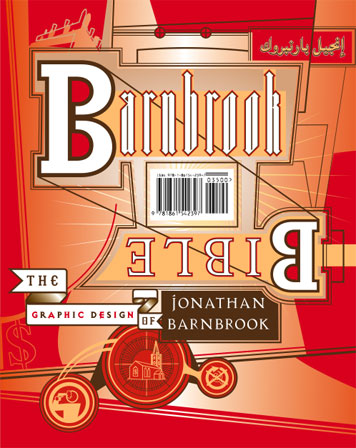
Barnbrook Bible, cover, 2007.
Jonathan Barnbrook's new book, Barnbrook Bible, ranks amongst the most ambitious personal projects undertaken by any graphic designer. It is a 330-page monograph bursting with dazzling refinement. Throughout the entire book there isn't a clumsy or unrefined typographic gesture — not a line that hasn't been weighted to perfection. The effect is like being in a Parisian patisserie — everywhere you turn there are mouth-watering options.
But the Barnbrook Bible is more than a bit fat monograph. It is a work of semi-autobiography, expressing the author's political anger and his aesthetic and professional philosophies. It therefore invites judgement by more demanding criteria than if it was just another design book. So, the big question is: does Barnbrook's magnum opus represent a species-jumping leap for graphic design, or is it the outpourings of a massive ego shot through with political rage and a fondness for typographic cartooning?
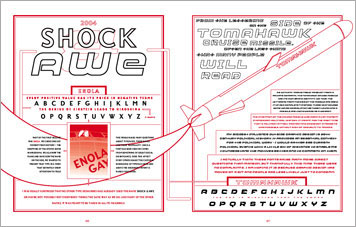
Barnbrook Bible, sample spread, 2007.
The Barnbrook Bible — which took 5 years to complete — is a comprehensive re-engineering of the designer's back catalogue, beginning with his student work and coming up to date with his Adbusters involvement. The book avoids a conventional structure; instead it is a fast-flowing river of textual and visual rhetoric. But "river" is a poor word to use in connection with the solemn precision of Barnbrook's work. He produces finely tooled graphic wizardry that distinguishes him from all other graphic designers at work today. He can mix a dozen fonts (all his own) on a single page — sometimes even changing typefaces mid-sentence — and it still looks coherent and exquisitely judged.
The spectre of religion hangs over this book. It begins with the odd-sounding note of the title and continues inside with Barnbrook's extensive use of religious symbolism and typographic conventions associated with English religious texts; Eric Gill's stark red-and-black typographic creed lives on in Barnbrook's design. The aesthetic flavour of Barnbrook's work is acutely English. It is the flavour of gravestones in rural churchyards, of dusty prayer books and the vivid lustre of stained glass windows. This iconography links Barnbrook to a traditionalist view of Englishness that is increasingly rare in multicultural Britain, and more commonly associated with reactionary conservatism.
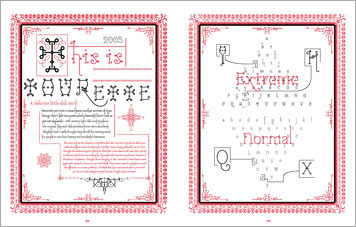
Barnbrook Bible, sample spread, 2007.
Which brings us to Barnbrook's political commentary. Barnbrook is a political radical: American foreign policy and global corporatism are his main targets. Most of this work is self-initiated and self-funded. Much of it is sharply effective — but there is also a callowness to it. Morphing Ronald MacDonald and Osama Bin Laden into a single iconic character is witty and diverting for about 3 seconds; although perhaps it has a higher purpose which is to infuriate corporate America and Al Qaeda supporters.
This callowness means it's easy to dismiss Barnbrook's political work as typographic cartooning (planes flying into perpendicular barcodes, for example), yet the sheer brilliance of his execution prevents us from doing this. In the past, revolutionary and oppositional movements have distinguished themselves by shunning formal graphic design because of its links to political and corporate power, and turned instead to more anarchic modes of graphic expression. But Barnbrook brings the gloss and ultra-refinement of cosmetics advertising to the task of exposing U.S. bombing statistics. It's an astonishing conjuring trick that he pulls off repeatedly.
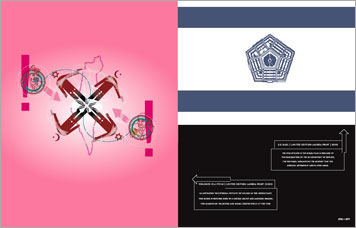
Barnbrook Bible, sample spread, 2007.
The final component in this book is Barnbrook's text. There are essays by Alice Twemlow, Teal Triggs, Kalle Lasn, Emily King and "three paragraphs by David Bowie," but the book mainly consists of Branbrook's own extensive writings which appear on nearly every page. He writes engagingly about font creation, his discovery of film-based work, and the conduct of the modern designer. His chapter on working with Damien Hirst is a cracking read.
I said earlier that this was a work of semi-autobiography. It is more accurately a work of "professional" autobiography, by which I mean that Barnbrook mainly confines his autobiographical observations to his work, and only fleetingly touches on personal matters. Nevertheless, he opens himself up for critical scrutiny in the way that all good autobiographers do. There's no self-love, no self-aggrandisement — just an old-fashioned obsession with right and wrong, good and evil, black and white. This occasionally manifests itself as sourness and personal bitterness; his dismissive response to objections to the Manson typeface is a good example of this.
I've recently got to know Barnbrook. Prior to meeting him I'd imagined him to be a stern moralist unlikely to be good company. Yet in the flesh Barnrook is an engaging, modest and uncensorious individual with a sly wit and an eccentric affection for Luton Town Football Club — just about the most unfashionable football club in football-mad Britain.
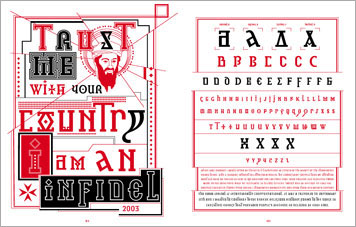
Barnbrook Bible, sample spread, 2007.
Something of the dour moralist (Alice Twemlow identifies it as a mixture of "anger, bitterness and melancholy") lingers in the pages of this book. But something else also emerges: an inspirational notion of sacrifice and self-denial. Barnbrook could make a great deal of money if he harnessed his ability to aestheticize everything he touches. Had he wanted to, he could have launched himself as the supreme stylist of his generation. Instead, he chose to follow his own path of dogged opposition to everything he despises. This seems to me to be brave — heroic even — in an age when we deny ourselves nothing, and refuse to make any personal sacrifices unless we are well paid.
Barnbrook is a throwback to an almost medieval notion of ascetic denial. He just does it with enough graphic flair to fuel a small power station.
Barnbrook Bible: The Graphic Design of Jonathan Barnbrook will be released in September. Published by Rizzoli, it is available from Amazon US and Amazon UK.
